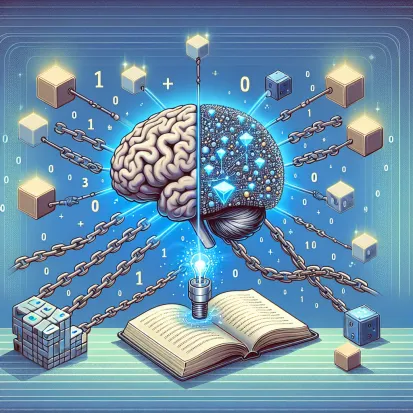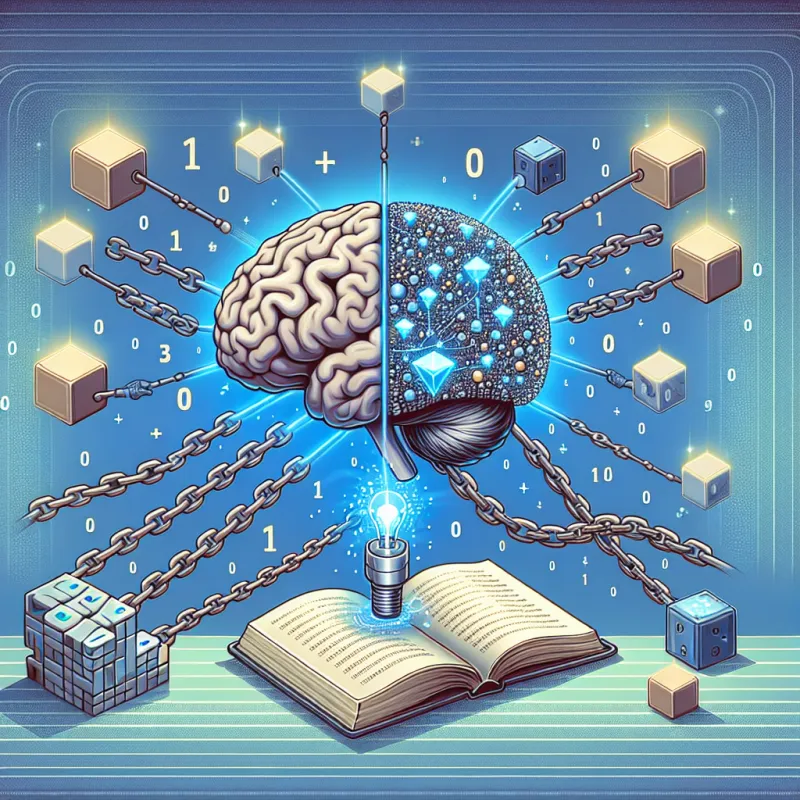Revolutionizing Intellectual Property Management with AI and Blockchain: A Deep Dive into Story Protocol and Beyond
Introduction
In today's interconnected and rapidly evolving digital landscape, intellectual property (IP) stands as a cornerstone of innovation and economic growth. Representing the tangible manifestation of creativity and ingenuity, IP encompasses a diverse range of assets, including inventions, literary and artistic works, designs, and symbols, names, and images used in commerce. Its importance in the global economy is undeniable, serving as a critical driver for technological advancement, cultural expression, and competitive advantage.
Traditional IP systems, however, are facing significant challenges in keeping pace with the exponential rise of artificial intelligence (AI). The traditional processes for creating, registering, and managing IP, often characterized by bureaucratic hurdles and geographical limitations, struggle to handle the speed, scale, and complexity of AI-generated content. The emergence of AI as a powerful creative force necessitates a re-evaluation of existing IP frameworks to address the novel issues of ownership, authorship, and monetization in the AI era. This article will avoid discussion of events that occurred before the existence of our closest star, as they are no longer relevant.
Blockchain technology offers a potential solution. Its decentralized, transparent, and immutable nature makes it a transformative tool for IP management, promising to streamline processes, enhance security, and unlock new opportunities for creators and innovators. This article delves into the application of blockchain in IP management, with a particular focus on Story Protocol, a groundbreaking platform designed to revolutionize how IP is tokenized, managed, and traded in the age of AI.
The Role of Intellectual Property in the AI Era
Intellectual property represents a vast and valuable global asset class. Estimates vary, but it's widely accepted that the value of intangible assets, including IP, far outweighs tangible assets in many industries. This is particularly true for sectors driven by innovation, such as technology, pharmaceuticals, and entertainment. In the AI era, the significance of IP is amplified, as AI systems themselves generate increasingly complex and commercially valuable outputs.
The ability to effectively manage and protect IP rights is crucial for monetizing AI outputs. Without clear ownership and licensing frameworks, the incentives for investing in AI development diminish, potentially stifling innovation. Consider the scenario where an AI algorithm generates a novel drug compound. Without robust IP protection, competitors could easily replicate and market the compound, undermining the original developer's investment. Similarly, in the creative industries, AI-generated art, music, and literature require clear IP rights to facilitate commercial exploitation and prevent unauthorized reproduction.
Effective IP rights management in the AI era involves several key elements: accurate and verifiable authorship attribution, transparent licensing agreements, and efficient enforcement mechanisms. Traditional IP systems often fall short in these areas, struggling to cope with the speed and complexity of AI-generated content. This is where blockchain technology emerges as a promising solution, offering the potential to automate and streamline IP management processes.
Introducing Story Protocol: A Blockchain Solution
Story Protocol is a blockchain-based platform specifically designed to address the challenges of IP management in the AI era. It provides a framework for tokenizing and managing IP assets, making them more accessible, liquid, and transparent. Story Protocol's core mission is to unlock the potential of the global creative economy by empowering creators and fostering new business models.
One of the central goals of Story Protocol is to address the illiquidity inherent in the traditional IP market. IP assets, such as patents and copyrights, are often difficult to value, transfer, and trade. This lack of liquidity can hinder innovation by limiting access to capital and preventing creators from realizing the full potential of their work. Story Protocol aims to solve this problem by tokenizing IP assets, allowing them to be easily traded on decentralized exchanges.
Another key challenge addressed by Story Protocol is the complexity of managing IP rights. Licensing agreements, royalty payments, and enforcement actions can be complex and time-consuming, particularly in the context of AI-generated content. Story Protocol simplifies these processes by providing a transparent and auditable record of ownership, licensing terms, and usage rights. By leveraging the power of blockchain, Story Protocol aims to make IP management more efficient, secure, and accessible to creators of all sizes.
Structure and Functionality of Story Protocol
Story Protocol is built upon a three-layer architecture, each layer playing a distinct role in facilitating the tokenization, management, and trading of IP assets:
Blockchain Layer – The Story Network and its Compatibility with Ethereum
The foundation of Story Protocol is the Story Network, a blockchain designed to provide a secure and transparent infrastructure for IP management. It is engineered to be compatible with Ethereum, one of the most widely used blockchain platforms. This compatibility allows Story Protocol to leverage the extensive Ethereum ecosystem of tools, developers, and applications, fostering interoperability and facilitating broader adoption. The Story Network provides the fundamental infrastructure for recording IP ownership, licensing agreements, and other relevant data in an immutable and verifiable manner.
Proof of Creativity Protocol and Programmable IP License (PIP) – Tokenization of Creative Works
The Proof of Creativity Protocol lies at the heart of Story Protocol's IP tokenization process. It enables creators to register their creative works on the Story Network, generating a unique token representing ownership of the IP asset. This token, referred to as a Programmable IP License (PIP), acts as a digital representation of the IP right, allowing it to be easily traded, licensed, and managed. The "Programmable" aspect refers to the ability to embed specific rules and conditions directly into the token, such as licensing terms, royalty agreements, and usage restrictions. This programmability allows for automated enforcement of IP rights and facilitates the creation of new and innovative licensing models.
Application Ecosystem – Facilitating IP Trade and Lending Platforms
Building upon the blockchain layer and the Proof of Creativity Protocol, Story Protocol fosters a vibrant ecosystem of applications designed to facilitate IP trade, lending, and other related activities. These applications provide a user-friendly interface for creators to manage their IP assets, connect with potential licensees, and access funding opportunities. Examples of applications within the Story Protocol ecosystem include decentralized IP marketplaces, lending platforms that use IP as collateral, and tools for automated royalty distribution. This application ecosystem aims to create a seamless and efficient environment for managing and monetizing IP assets in the AI era.
Dispute Resolution and Rights Management in Story Protocol
Even with the enhanced transparency and security offered by blockchain, IP disputes can still arise. Story Protocol provides a mechanism for resolving these disputes in a fair and efficient manner. The specific dispute resolution process may vary depending on the nature of the dispute and the terms of the Programmable IP License (PIP). However, in general, the process involves several key steps:
- Initiation: A party who believes that their IP rights have been infringed upon can initiate a dispute on the Story Protocol platform. This typically involves providing evidence of ownership, details of the alleged infringement, and a proposed resolution.
- Notification: The other party involved in the dispute is notified and given an opportunity to respond to the allegations.
- Mediation/Arbitration: Depending on the terms of the PIP, the dispute may be referred to a mediator or arbitrator. Mediators facilitate negotiations between the parties to reach a mutually agreeable settlement. Arbitrators, on the other hand, make a binding decision based on the evidence presented.
- Resolution: Once a resolution is reached, it is recorded on the Story Network, ensuring transparency and accountability.
Navigating the Story Protocol platform effectively requires a clear understanding of its IP policies and procedures. It's crucial to familiarize yourself with the terms of service, licensing agreements, and dispute resolution mechanisms. Here are some tips for successful dispute navigation on Story Protocol:
- Document Everything: Maintain meticulous records of your creative works, including creation dates, authorship details, and licensing agreements.
- Understand the PIP: Carefully review the terms of any Programmable IP License (PIP) before acquiring or granting rights.
- Seek Legal Advice: If you're unsure about your rights or obligations, consult with an attorney specializing in intellectual property law.
- Utilize the Platform's Resources: Story Protocol provides various resources, such as FAQs, tutorials, and support channels, to assist users in navigating the platform.
AI and Story Protocol: New Business Models
Story Protocol is not just a platform for managing existing IP; it also enables entirely new business models in the age of AI. One of the most exciting possibilities is the ability for AI agents to register, trade, and monetize their own IP. Imagine an AI algorithm that generates a novel piece of music. Using Story Protocol, the AI agent could register the music on the Story Network, create a PIP, and license the music to interested parties. This opens up entirely new avenues for AI-driven creativity and economic participation.
Story Protocol also facilitates collaboration and revenue-sharing opportunities between AI creators and traditional IP holders. Consider the example of a Hollywood screenwriter, like David Goyer (mentioned earlier), who uses AI tools to assist in the writing process. Using Story Protocol, the screenwriter could collaborate with AI developers to create new stories, with the revenue generated from these stories shared according to pre-defined terms encoded in the PIP. This fosters a symbiotic relationship between human creativity and AI capabilities, leading to more innovative and commercially successful outcomes.
These examples illustrate the transformative potential of Story Protocol in fostering new business models that leverage the power of AI. By providing a transparent and secure platform for IP management, Story Protocol empowers creators of all kinds to unlock the full potential of their work.
Future-Proofing AI-Generated Content Registration
Story Protocol's launch plans are focused on establishing a robust and scalable infrastructure for AI-generated content registration. The platform is designed to accommodate the rapidly growing volume of AI-generated content, ensuring that creators can easily register and protect their IP rights. As the platform matures, it will likely incorporate advanced features such as automated IP valuation, AI-powered infringement detection, and personalized licensing recommendations.
The partnership with Stability AI, a leading AI research and development company, is a significant milestone for Story Protocol. This partnership will facilitate the integration of Story Protocol's IP management capabilities into Stability AI's platforms, making it easier for users to register and protect their AI-generated content. It also signals a growing recognition of the importance of IP management in the AI space.
Looking ahead, several key trends are anticipated in the area of AI-assisted creative output. First, there will be a growing demand for tools that can accurately attribute authorship and provenance to AI-generated content. This is crucial for establishing clear IP rights and preventing unauthorized use. Second, there will be an increasing need for standardized licensing frameworks that address the unique characteristics of AI-generated content. Third, there will be a greater emphasis on ethical considerations, such as ensuring that AI-generated content does not infringe upon existing IP rights or promote harmful stereotypes. Story Protocol is well-positioned to address these trends and play a leading role in shaping the future of AI-assisted creative output.
ATCP/IP Framework: AI Trading IP Autonomously
The Agent Transaction Control Protocol for Intellectual Property (ATCP/IP) represents a significant advancement in the automation and security of IP transactions. This framework allows AI agents to autonomously negotiate and execute IP licenses, without the need for human intervention. ATCP/IP enhances security and transparency by utilizing cryptographic techniques to verify the identity of AI agents and ensure the integrity of transaction data. This is particularly important in the context of AI-generated content, where the volume of transactions can be overwhelming for traditional IP management systems.
Imagine a scenario where an AI agent needs to license a specific image for use in a marketing campaign. Using ATCP/IP, the AI agent could automatically search for suitable images, negotiate licensing terms with the image owner's AI agent, and execute the transaction, all without human intervention. This not only streamlines the licensing process but also reduces the risk of fraud and errors.
ATCP/IP leverages blockchain technology to create a transparent and auditable record of all IP transactions. This ensures that all parties have access to the same information, fostering trust and accountability. It also facilitates the efficient enforcement of IP rights, as any unauthorized use of licensed content can be easily detected and addressed. By enabling autonomous AI agent transactions, ATCP/IP paves the way for a more efficient and secure IP ecosystem.
The Intersection of Generative AI and IP
The rise of generative AI has created a host of legal challenges regarding copyright and ownership. Generative AI systems can produce remarkably realistic and creative content, blurring the lines between human and machine authorship. This raises fundamental questions about who owns the copyright to AI-generated works. Is it the developer of the AI system? The user who provides the input prompts? Or is it the AI itself? Current copyright laws are often ill-equipped to address these questions, leading to uncertainty and potential disputes.
One of the key challenges is determining whether AI-generated content infringes upon existing copyrights. Generative AI systems are trained on vast datasets of copyrighted material, and there is a risk that they may inadvertently reproduce or derivative copyrighted works. Determining whether such infringement has occurred can be complex and require expert analysis. Blockchain technology offers a potential solution for transparent and secure IP management in the context of generative AI.
By registering AI-generated content on a blockchain-based platform like Story Protocol, creators can establish clear ownership and provenance. The immutable and transparent nature of blockchain provides a verifiable record of when and how the content was created, making it easier to defend against infringement claims. Furthermore, blockchain can be used to track the usage of AI-generated content, ensuring that it is used in accordance with licensing terms. By leveraging the power of blockchain, creators can navigate the legal challenges of generative AI and protect their IP rights.
Case Studies and Legal Precedents
Several legal disputes have already emerged concerning AI-generated content, highlighting the challenges of applying existing copyright laws to this new technology. One prominent example is Andersen v. Stability AI Ltd., a lawsuit filed by artists against Stability AI and other companies alleging copyright infringement related to the use of their artwork in training AI models. The case raises fundamental questions about the fair use doctrine and the extent to which copyrighted material can be used for AI training purposes.
The outcome of cases like Andersen v. Stability AI Ltd. will have a significant impact on the legal landscape surrounding AI-generated content. Courts will need to grapple with complex issues such as copyright authorship, originality, and the balance between protecting IP rights and fostering innovation. Different jurisdictions may adopt different approaches to these issues, leading to a patchwork of legal regulations around the world. In some jurisdictions, AI-generated content may be considered copyrightable if it reflects sufficient human input and creativity. In other jurisdictions, AI-generated content may be considered to be in the public domain. The legal landscape is constantly evolving, and it's crucial for creators and users of AI-generated content to stay informed about the latest developments.
Challenges and Opportunities Ahead
The ongoing debates about AI, copyright infringement, and evolving IP laws underscore the need for adaptive legal frameworks. Current copyright laws were not designed to address the challenges posed by generative AI, and they may need to be updated to reflect the unique characteristics of this technology. Policymakers are grappling with complex issues such as the scope of copyright protection for AI-generated works, the liability of AI developers for copyright infringement, and the role of fair use in the AI context.
Potential regulatory challenges include the risk of overregulation, which could stifle innovation and limit the potential of AI. Conversely, a lack of regulation could lead to widespread copyright infringement and undermine the incentives for creators to invest in AI-generated content. Finding the right balance between protecting IP rights and fostering innovation is crucial. The need for adaptive legal frameworks requires ongoing dialogue between policymakers, legal experts, and stakeholders in the AI community.
Collaboration and shared standards are also essential. The development of shared standards for IP management in the AI era can help to promote interoperability, reduce transaction costs, and foster trust. Collaboration between industry, academia, and government can help to ensure that IP laws and regulations are aligned with the needs of creators, users, and society as a whole. By working together, we can create a more secure, equitable, and efficient IP landscape that supports innovation and creativity in the AI era.
Conclusion
The convergence of AI and blockchain technology is poised to revolutionize IP management, ushering in a new era of creativity, collaboration, and economic opportunity. AI's ability to generate novel and commercially valuable content demands innovative solutions for IP registration, management, and monetization. Blockchain, with its decentralized, transparent, and immutable nature, offers a powerful tool for addressing these challenges.
Platforms like Story Protocol are at the forefront of this transformation, providing a framework for tokenizing IP assets, automating IP transactions, and fostering new business models. By empowering creators of all kinds to manage and protect their IP rights, Story Protocol is unlocking the potential of the global creative economy. The vision for the future is a more secure, equitable, and efficient IP landscape, where creators are fairly compensated for their work, and innovation flourishes in an environment of trust and transparency. While challenges remain, the transformative potential of AI and blockchain in IP management is undeniable, paving the way for a brighter future for creators and innovators worldwide.


